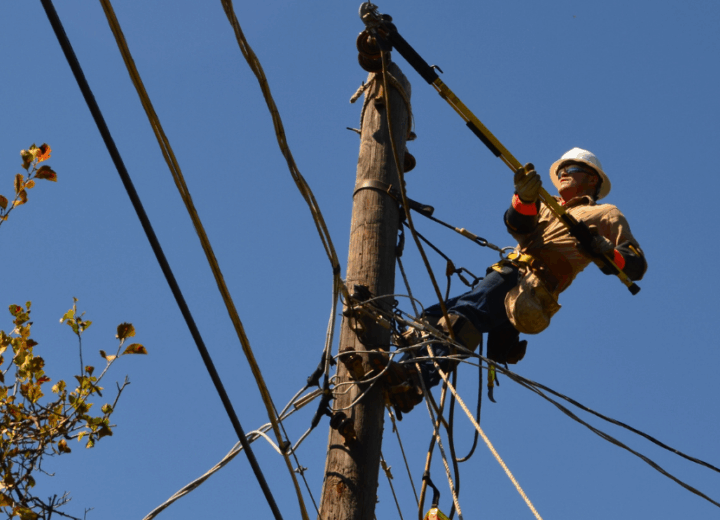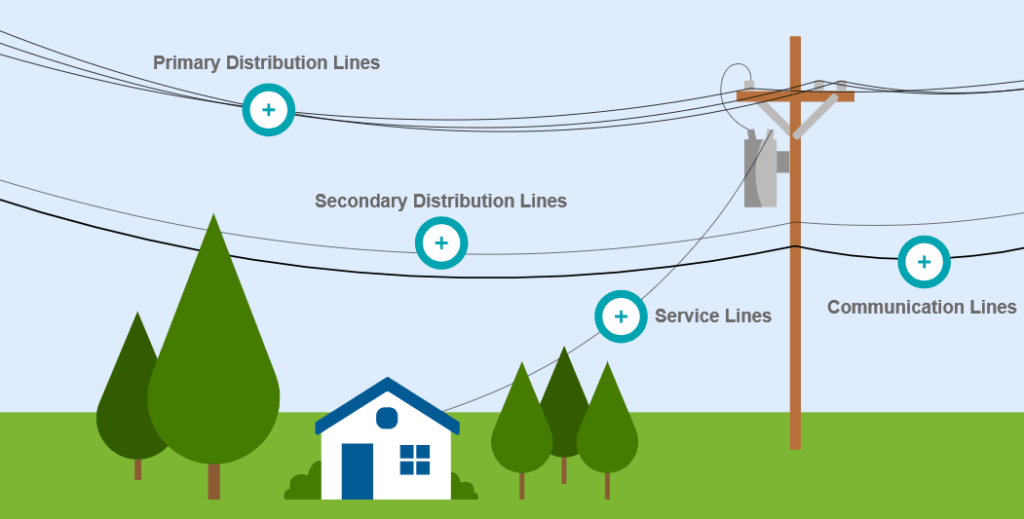We’re committed to keeping our customers informed about what matters most to them. Over the past month, customers like you have had questions about power outages, electric infrastructure and usage and forestry maintenance. If you’re also wondering about these topics, you’re in the right place. Below are answers to your most frequently asked questions.
Outages:
Why do we see more power outages in the summer?
Power outages happen for many reasons, and we typically see an increase during the summer months. This is often due to storms that bring strong winds, causing trees and debris to fall onto and bring down power lines. AEP’s meteorology team constantly monitors the weather to help us prepare and respond quickly to restore power.
Trees are one of the top causes of outages. Our forestry crews trim and remove trees near our equipment to prevent outages and keep the power flowing. Trees from outside our right-of-way may also fall and cause outages. Learn more about our tree-trimming efforts.
Other common causes of outages include vehicle accidents, animals and damaged equipment. Rest assured, our crews are continually working to strengthen the grid to reduce these risks.
We understand that power outages are never convenient. If an outage occurs, our crews are prepared to restore power safely and as quickly as possible.
Why do estimated restoration times change?
When an outage is reported, our system automatically estimates the average time it takes for our crews to restore service. That time may change once a crew arrives on scene, assesses the damage and determines what’s needed to restore power. Sometimes crews find other issues or complications when investigating the cause of an outage, causing the restoration time to be pushed back. If the expected restoration time changes and you’re signed up for alerts, you’ll receive an update with the new estimated time, as well as confirmation once power has been restored.
Enroll in text notifications at AEPOhio.com/Alerts and visit AEPOhio.com/OutageMap for outage information.
Infrastructure and Usage:
Why can’t you bury all the lines?
Many factors determine whether power lines are buried underground or built overhead. Both options have pros and cons. While overhead lines are more vulnerable to damage from weather, trees, animals and vehicle accidents, underground lines are costlier to install and issues often take longer to locate and repair, sometimes resulting in longer power outages compared to overhead lines. Our goal is to find the best solution to provide our customers with reliable power.
With the new data center tariff, will data centers pay for only 85% of the energy they use?
No, data centers will pay for 100% of the energy they use. Data centers generally require new electricity infrastructure to be built to bring them the large amounts of energy they say they’ll need. This tariff means that the data centers will have to make accurate estimates of their energy usage, so those infrastructure investments are right-sized. If their estimates are off and they end up using less than they said they’d need, they’ll still have to pay as though they used more energy to offset the infrastructure costs. If they use the same or more energy than they estimated, they’ll pay for 100% of the energy they used, like other customers. For example, if a data center requests 100 MW of energy but ends up using only 65 MW, they still must pay for at least 85 MW even though they didn’t use that much.
Forestry:
Why do forestry crews leave branches after tree trimming?
Forestry cleanup differs between routine maintenance and storm and outage restoration efforts.
During routine maintenance, crews clean up branches in maintained lawn areas and leave wood and stumps behind. In non-maintained areas, wood and branches are left to decompose naturally. Cleanup crews may arrive a few days after our maintenance work is complete.
During outages and following storms, our forestry crews must move quickly to clear the way for line workers to restore power. This is why property owners are responsible for cleaning up and disposing of the trees or branches cut by our forestry crews once it’s safe to do so.
Why do foresters trim only around certain wires?
During routine tree-trimming maintenance, our forestry crews look for trees or branches that could impact your electric service.
We maintain trees and branches around:
- Primary distribution lines: The lines located highest on the pole, typically located above the transformer.
- Secondary distribution lines: The lines located below the transformer. Crews may trim and/or remove trees around them if they believe the vegetation could pose a threat to your electric service.
We do not maintain trees and branches around:
- Service lines: The line that runs from our pole to your house.
- Communication lines: The lowest lines on the poles, owned by cable, internet or phone companies.
The image below shows the different lines that may be on a pole. You can view an interactive version and more information at AEPOhio.com/Trees.




This all sounds good. But you’re making a large profit so why the 35% increase in my bill?
Hi Beverly. We’re glad you’re finding our FAQ series valuable. Bills can increase for many reasons, but the main driver is how much energy a customer uses. When the temperature rises, customers may be consuming a lot more energy as their air conditioner works overtime to keep their home cool, even if they don’t adjust the thermostat. Sometimes there are other factors at play, like the accumulated balance on a budget plan coming due or a customer choosing to leave the Average Monthly Payment plan. Please reach out to our Customer Solutions Center and someone will be happy to go over your bill with you. They can be reached by sending a direct message on Facebook or X, or by calling 800-672-2231.
Us retired people can’t afford anymore rate increases, I’m on social security and the check I get monthly does not keep up. I know electricity is a necessity but damn it is ridiculous. I had to go back to work to make ends meet. I never made 40$ hour like your poeple do. It needs to stop.
Thank you for this information. Many lines here in Dublin, Ohio appear to be underneath us.
I’m retired. I cannot just arbitrarily ask for an increase in income. All utilities, including AEP, must come to their senses and STOP this relentless series of rate increases!
And especially, DO NOT even think about building a new corporate HQ building and the raise our rates to pay for that unnecessary expenditure.
How many raises have the AEP Executives received in the last five years? Are they REALLY doing enough to earn that? I doubt it.
No more rate increases.
The link to the “Understand The Difference” between AEP Ohio and AEP your parent company is broken.
Sorry about that, Carla. It’s been fixed now.